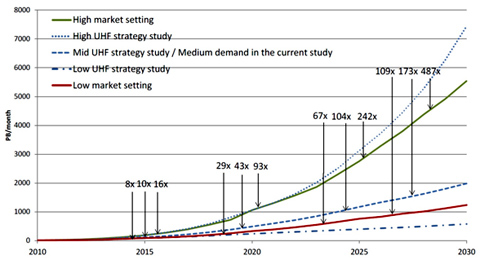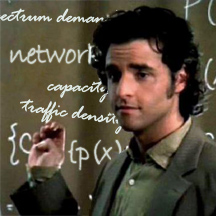Saturday 15 February, 2014, 14:01 - Spectrum Management
Posted by Administrator
When Goldilocks visited the house of the three bears, she tried their porridge and found one bowl too hot, one too salty but the third one just right. It seems that the ITU may have employed Goldilocks to help them put together their forecasts for mobile spectrum demand. Why? Read on...Posted by Administrator
 Leafing through the various responses to Ofcom's mobile data strategy consultation, one particular response raised more than an eyebrow. The response from the European Satellite Operators' Association (ESOA) points out that the model used by Ofcom to calculate the demand for spectrum for IMT (mobile broadband) services has a great big, whoppingly large, error in it. The model is based on that of the ITU which and is snappily titled 'ITU-R M.1768-1'. It was originally used at the 2007 World Radiocommunication Conference (WRC-07) to set expectations on how much spectrum would be required for mobile broadband services up to, and including, the year 2020.
Leafing through the various responses to Ofcom's mobile data strategy consultation, one particular response raised more than an eyebrow. The response from the European Satellite Operators' Association (ESOA) points out that the model used by Ofcom to calculate the demand for spectrum for IMT (mobile broadband) services has a great big, whoppingly large, error in it. The model is based on that of the ITU which and is snappily titled 'ITU-R M.1768-1'. It was originally used at the 2007 World Radiocommunication Conference (WRC-07) to set expectations on how much spectrum would be required for mobile broadband services up to, and including, the year 2020.At the time (2007), the ITU model predicted that by 2010, between 760 and 840 MHz of spectrum would be needed for IMT services. In reality, in most countries, little more than 400 MHz was actually available. And yet, ironically, the amount of data traffic being carried was far in excess of that which the ITU predicted. Not deterred by this apparent flaw in their logic, the model has been updated this year and a new set of results published. These new results show a demand for spectrum by 2020 of between 1340 and 1960 MHz.
 What ESOA have spotted, is that if you apply the traffic densities which consultancy RealWireless have assumed in their work for Ofcom, or those developed by the ITU, the resulting total traffic for the UK would be orders of magnitude greater than the actual traffic forecasts. Figures 40 and 44 of their report clearly repeat these errors. The ESOA consultation response illustrates it quite nicely, as follows:
What ESOA have spotted, is that if you apply the traffic densities which consultancy RealWireless have assumed in their work for Ofcom, or those developed by the ITU, the resulting total traffic for the UK would be orders of magnitude greater than the actual traffic forecasts. Figures 40 and 44 of their report clearly repeat these errors. The ESOA consultation response illustrates it quite nicely, as follows:| Type | Area (sqkm) | Traffic Density (PB/month/sqkm) | Traffic (PB/month) |
|---|---|---|---|
| Urban | 210 | 30 - 100 | 6300 - 21000 |
| Suburban | 4190 | 10 - 20 | 41900 - 83800 |
| Rural | 238600 | 0.03 - 0.3 | 7160 - 71600 |
| Total | 234000 | 55360 - 176400 |
What this shows it that the total monthly traffic for the UK, as calculated from the RealWireless traffic assumptions is between 55,360 and 176,400 PB (Peta Bytes) per month. Compare this to their traffic forecasts which show the total UK traffic reaching around 1000 PB/month by 2020 even in the 'high market setting' in the chart below.

Source: Figure 40 of 'Study on the future UK spectrum demand for terrestrial mobile broadband applications', 23 June 2013
So if the ITU and Ofcom models assume traffic levels of 100 times greater than reality, why is the resulting demand for spectrum which it outputs in line with many other industry predictions? Without digging deeply into the model (which is immensely complex), it's difficult to say, but it stands to reason that there must be some assumptions that have been 'adjusted' to make the results seem believable - fiddle factors as they're normally called.
 This is where Goldilocks comes in:
This is where Goldilocks comes in:- If the ITU model produced a result which said that 20,000 MHz of spectrum was needed for mobile broadband by 2020 (which it ought to given the high data traffic it is trying to model), no one would believe it - too hot!
- If it had said that 200 MHz of spectrum was needed it would equally have not been believed - too salty!
- But as it produces a result around 2000 MHz it is seen as just right!
Indeed the ITU themselves seem to recognise that there is some fiddling going on in a note they provide hidden deep in the annexes in their paper entitled ITU-R M.2290-2014 which says:
The spectrum efficiency values ... are to be used only for spectrum requirement estimation by Recommendation ITU-R M.1768. These values are based on a full buffer traffic model... They are combined with the values of many other parameters ... to develop spectrum requirement estimate for IMT. In practice, such spectrum efficiency values are unlikely to be achieved.
 What a 'full buffer traffic model' is, is anyone's guess but it seems to suggest that this factor, and others, may not be values that mobile operators or anyone else for that matter, would recognise. The problem with any complex model of this type is that it is difficult to understand except by the academic elite that prepared it (or by Charlie Eppes on Numb3rs), and equally difficult to sense-check. It seems that the sense checking has not taken place and what is left succumbs to the old computing law, "garbage in = garbage out". Many countries have done their own calculations and in many cases these have shown smaller figures than those espoused by the ITU, some have shown higher figures. Where such figures are based on the ITU model itself, they should, of course, now be taken with a very large pinch of salt.
What a 'full buffer traffic model' is, is anyone's guess but it seems to suggest that this factor, and others, may not be values that mobile operators or anyone else for that matter, would recognise. The problem with any complex model of this type is that it is difficult to understand except by the academic elite that prepared it (or by Charlie Eppes on Numb3rs), and equally difficult to sense-check. It seems that the sense checking has not taken place and what is left succumbs to the old computing law, "garbage in = garbage out". Many countries have done their own calculations and in many cases these have shown smaller figures than those espoused by the ITU, some have shown higher figures. Where such figures are based on the ITU model itself, they should, of course, now be taken with a very large pinch of salt. To take a real life example, Verizon Wireless in the USA claimed in June 2013 that:
To take a real life example, Verizon Wireless in the USA claimed in June 2013 that:57 percent of Verizon Wirelessí data is carried on its 4G LTE.
Putting this in perspective, Verizon has around 40% of the US market and is using just 20 MHz of spectrum for its LTE network. This means that with an LTE network using 5 times as much spectrum (i.e. 100 MHz), it ought to be possible to carry the whole of the US's mobile data traffic today. Allowing for growth in data traffic of 33% per year (a figure which both Vodafone and Telefonica have cited as their actual data growth in 2013), and by 2020 the US would need a total of 740 MHz of spectrum for mobile data, a far cry from the 1960 MHz being demanded by the ITU. And the 740 MHz figure does not take into account any additional savings that might be realised using more efficient technology such as LTE-Advanced.
The inexorable growth in demand for mobile data is not in question, though at some point it will become too expensive to deliver the 'all you can eat' packages that people expect. Who is going to pay US$10 to download one film on their mobile when the subscription to Netflix for the whole month is less than that, and they could use their home WiFi and do it for next to nothing? What is now in question is how much spectrum you need to deliver it. Maybe a good starting point would be to stop where we are and wait a few years for things to settle down, and then see what the real story is. Maybe Goldilocks will have run into the forest to hide from the ITU, and a new bowl of porridge will have been made that tastes a whole lot better.
add comment
( 1773 views )
| permalink
| 



 ( 2.8 / 1257 )
( 2.8 / 1257 )




 ( 2.8 / 1257 )
( 2.8 / 1257 )

